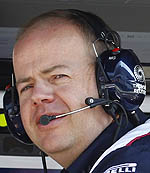- Home
-
News
-
Latest News
- Ferrari and HP confirm partnership
- "If they want blood, I'm ready," says Mario Andretti
- Ferrari set to announce new title sponsor
- Mercedes cannot depend on season's "bright spots", insists Wolff
- "We made too many mistakes," admits Vasseur
- Sport targets new points system
- Horner defends Verstappen dominance
- Chinese Grand Prix in Words, Stats and Pictures
- Toto's problems aren't his drivers, says Horner
- More News
-
-
Drivers
-
Current Drivers
- Max Verstappen
- Logan Sargeant
- Daniel Ricciardo
- Lando Norris
- Pierre Gasly
- Sergio Perez
- Fernando Alonso
- Charles Leclerc
- Lance Stroll
- Kevin Magnussen
- Yuki Tsunoda
- Alexander Albon
- Guanyu Zhou
- Nico Hulkenberg
- Esteban Ocon
- Lewis Hamilton
- Carlos Sainz
- George Russell
- Valtteri Bottas
- Oscar Piastri
- Test/Reserve Drivers
-
- Teams
-
Tracks
-
Current Circuits
- Sakhir (Bahrain)
- Jeddah (Saudi Arabia)
- Melbourne (Australia)
- Suzuka (Japan)
- Shanghai (China)
- Miami (USA)
- Imola (Italy)
- Monte Carlo (Monaco)
- Montreal (Canada)
- Barcelona (Spain)
- Red Bull Ring (Austria)
- Silverstone (UK)
- Budapest (Hungary)
- Spa-Francorchamps (Belgium)
- Zandvoort (Netherlands)
- Monza (Italy)
- Baku (Azerbaijan)
- Singapore (Singapore)
- Austin (USA)
- Mexico City (Mexico)
- Interlagos (Brazil)
- Las Vegas (USA)
- Losail (Qatar)
- Abu Dhabi (UAE)
-
- Seasons
- Pictures
- Stats
- JOHNNYBET

 Pastor Maldonado: The German fans who visit Hockenheim create a good atmosphere, particularly in the final few corners with the big grandstands, so it's a fun circuit to drive. The final sector is also challenging with lots of corners coming quickly after each other where time can be won or lost. I'm disappointed to not have scored points in the last race but our car is showing that it can compete at different circuits so I'm feeling confident heading into this weekend.
Pastor Maldonado: The German fans who visit Hockenheim create a good atmosphere, particularly in the final few corners with the big grandstands, so it's a fun circuit to drive. The final sector is also challenging with lots of corners coming quickly after each other where time can be won or lost. I'm disappointed to not have scored points in the last race but our car is showing that it can compete at different circuits so I'm feeling confident heading into this weekend.



















sign in